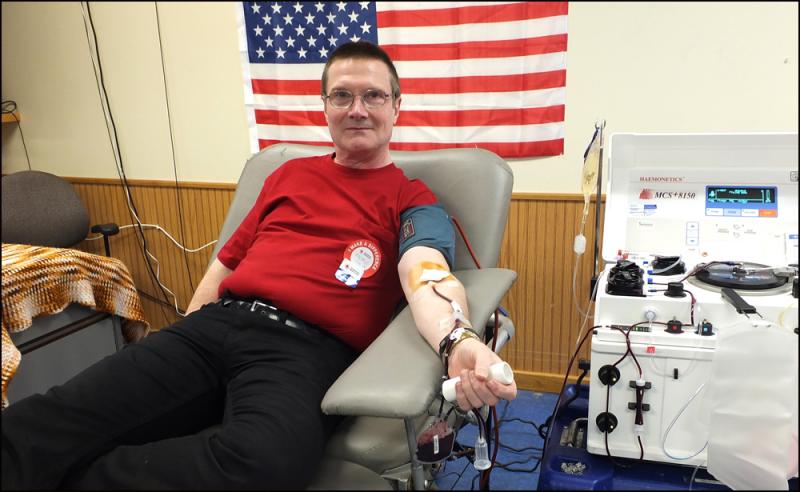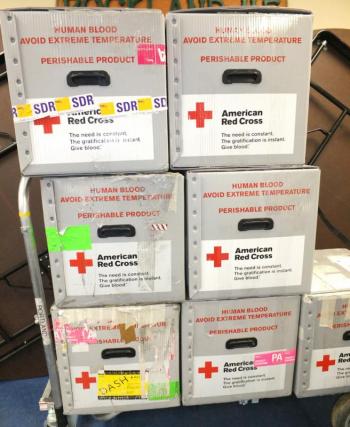Weather takes its toll on Red Cross blood drives
ROCKLAND – The American Red Cross held a blood drive at the American Legion Post 1 on Thursday, February 22. Winter months are particularly hard on blood drives as the winter weather can cause cancellations and affect the number of units of blood that the region needs to maintain a good supply. In February alone, more than 100 blood drives were cancelled. That equates to around 3,800 units of blood and platelets.
Sammy Henebury, team supervisor, has worked for the American Red Cross for 12 years. She grew up in Boston and moved to Westbrook, going to work for the Red Cross one month later.
"When we show up we have 45 minutes to set up," she said. "So we bring everything in and we have to do quality checks on all the equipment and put it all together.”
At the American Legion, in Rockland, the team set up eight beds, a screening area and a snack area to get ready for the day. Henebury said there are a number of factors that determines what gets set up.
"It all depends on our goal and the number of staff we have," she said. "And, how many people we expect to see. Some people already have appointments and you can do that right online."
Henebury said the team expected to see 35 to 40 people, and that is about average.
"We do four to five blood drives a week," she said. "The winter snows were hard on the blood drives, but people do come out and try to help with that deficit."
You can donate blood every 56 days and that is a federal regulation. Henebury said it takes about an hour to give blood.
"That's from the screening to the snack table," she said. "A lot of people really enjoy the snack table. That's a popular spot."
Tom Hinman is the marketing manager for the American Red Cross Biomedical Services.
Hinman lives in North Yarmouth and covers Maine, Vermont, New Hampshire and Eastern Massachusetts. He's worked in his job for four years.
"Every day, the Red Cross has to collect 14,000 units of blood across the country,” he said. “My area is one of 75 blood banks and it needs to collect blood for trauma patients, cancer patients, burn victims and people with rare blood diseases. It's an ongoing need everyday for blood."
Hinman said winter time is a tough time to collect blood in New England.
"It's a very tough time because of weather," he said. "Up here in Maine we have nor’easters. There are large snow storms and ice storms. And then there are things called the flu and colds. It's possible that between December and March, we could be an importing region for blood. And then April through November we are an exporting region. And different regions have to deal with natural disasters, too."
Hinman said there are two ways to collect blood.
"We can collect whole blood, which comprises the three components of blood — red blood cells, platelets and plasma," he said. "We can also collect what we call our power red process. It's and automated process that takes a unit of whole blood out of a donor. We spin out the red blood cells and return the platelets and plasma along with some saline solution and return it to the donor."
So what happens to the unit of blood after it's taken, and where does it go?
"We take the unit of blood and we'll take six tubes of it to get tested, "he said. "All that blood that gets collected today in New England will wind up in Dedham, Massachusetts, tonight. It all gets spun down and separated into red blood cells, platelets and plasma. We use those tubes to test for AIDS, HIV and hepatitis and just in the last year we started testing for the Zika Virus."
Hinman said you need to be at least 16 years old to give blood and there is no upper limit as long as you're healthy. If you travel abroad to areas that have malaria you can't give blood, or people who might have been in England during the Mad Cow situation.
"Sixty two percent of the population can't give blood, 38 percent can, but less then eight percent do," he said. "If you take a population of 100 people eight of those people can give blood and they probably do 1.6 times a year verses they could donate up to six times a year."
Hinman said if that 1.6 times a year could get bumped up to two, we would eliminate the blood shortage. If we could take that eight percent and move it up to 10 percent, we would eliminate the blood shortage in America.
Hinman said AB(-) and AB(+) are the rarest bloods. O negative is the most common and is known as the universal donor.
"In New England, for whatever reason, based on our demographics, we have some of highest population of O negative blood donors,” he said. “Seven percent of the population is O negative and it will go out within 24 hours when it hits our shelves."
Hinman said there is a perception that the American Red Cross is a part of the government. It is not and consists of five distinct services.
"We're a nonprofit agency and we receive no funding whatsoever from the government," he said. "All the money is done through fundraising over the year."
The five divisions are:
Humanitarian Services helps with disasters. They are helping communities to recover.
The Biomedical Division is responsible for blood drives and collecting all the units that is needed every day, its testing and distribution around the country.
The Health and Safety Division put on trainings around the country: CPR, first aid, life saving classes, babysitting and life guarding.
The Services to the Armed Services field calls from all around the country from families who need help getting in touch with men and women of the military that may be deployed all over the world.
The final division works to support the services of the International Red Cross. Countries around the world have their own Red Cross organization, but the American Red Cross may work to help that organization with their own natural disasters.


























